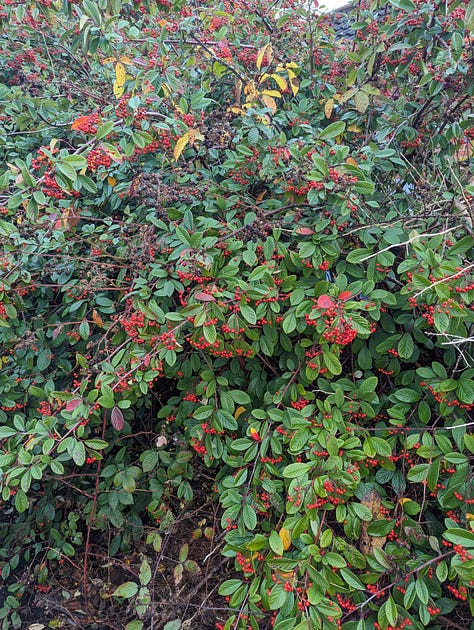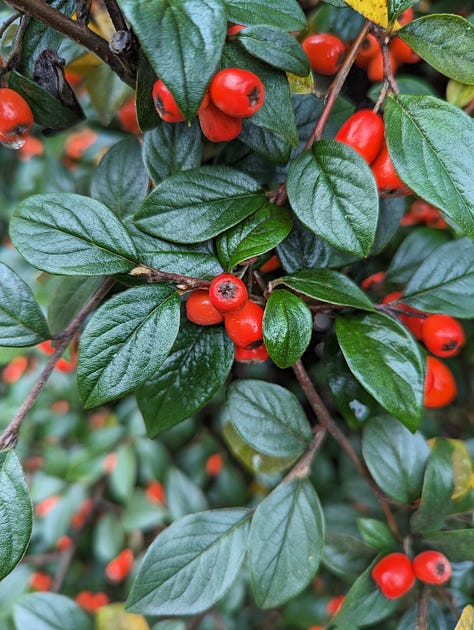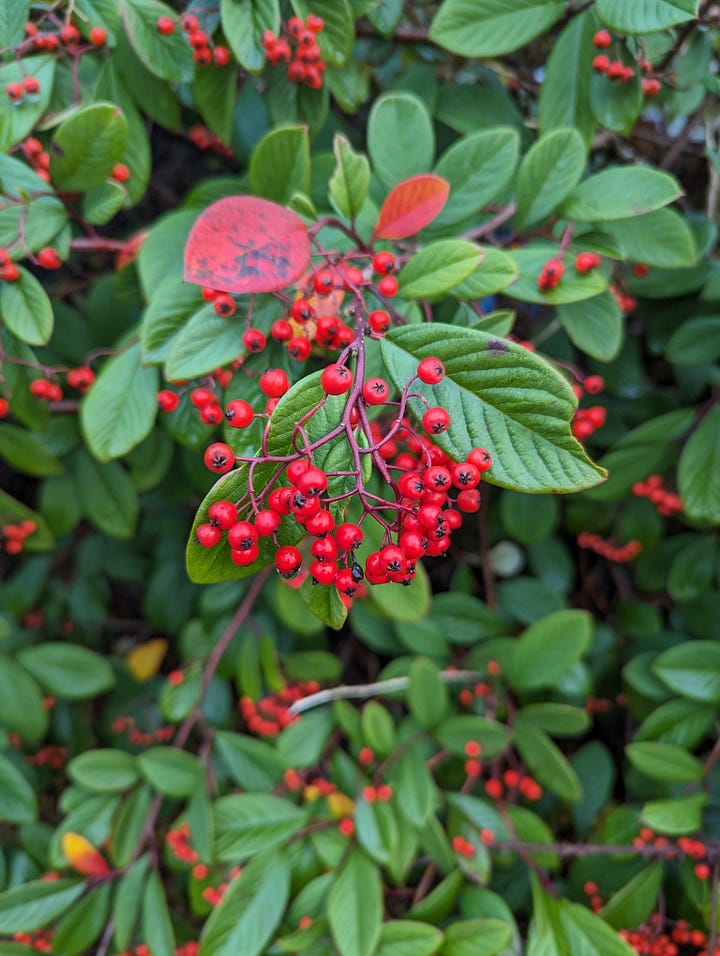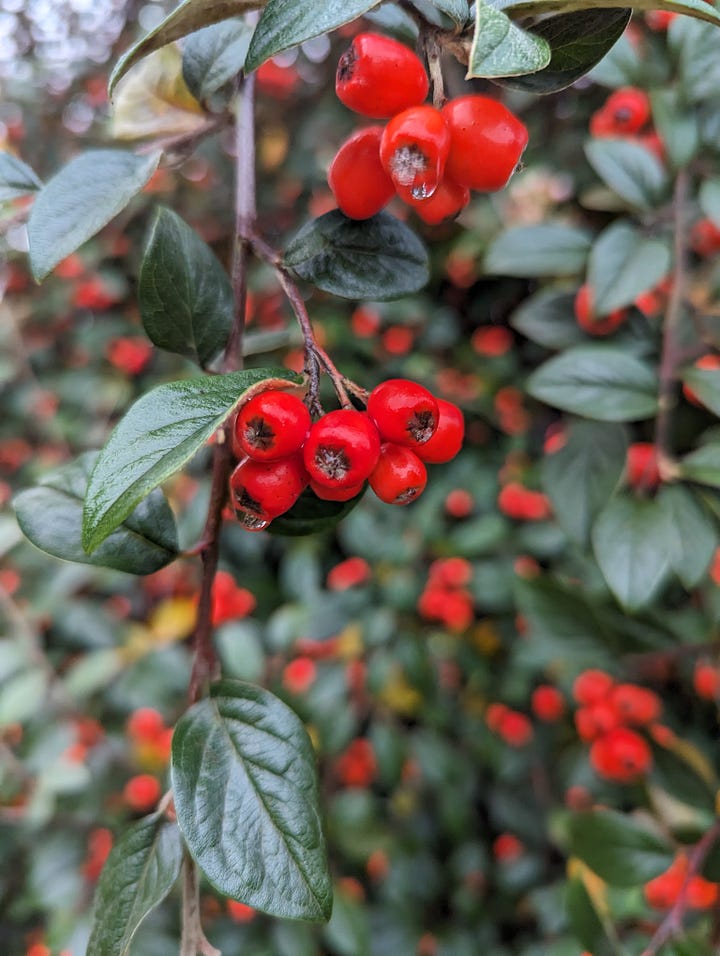When I was a child (not that long ago..), I was taught by the adults in my life that all berries I saw growing in the wild were poisonous. This was really tempting fate, in hindsight, because whoever planned our school grounds didn’t get the memo and planted a huge thicket of snowberry (Symphoricarpos) at the far end of the play ground. How do I remember the genus? We definitely didn’t spend hours throwing the berries at each other, or stamping them for the delicious popping sensation.
According to the childhood lexicon, red berries were even more toxic. Don’t you know that nature made the fruits bright red to warn off potential predators? Or so the lessons continued.
I get it, to an extent. A few near misses or fatalities can have that effect on an entire generation. As we have lost our hard earned cultural knowledge - hard earned as someone would have probably figured out that this red berry is sweet but bad, and that red berry is astringent but good - it’s safer to institute blanket bans.
Better safe than sorry, so the adage goes.
And clearly society has failed to hammer this message into my brain, because here I am, wondering whether that red berry is edible.
That red berry, in this case, is the Cotoneaster.





Around my suburban neighbourhood, people like to grow Cotoneaster as a decorative shrub. Wall Cotoneaster (C. horizontalis) is particularly prized for those awkward spots. As the namesake suggests, it is great for the wall microclimate. Tolerant of dry spots at the foot of a wall and naturally growing in big flat sprays; what’s not to love?
Moving further up the canopy, we have the hollyberry cotoneaster (C. bullatus) which has really quite a beautiful tree form when allowed to grow freely.
One of the reasons that cotoneaster is so beloved for ornamentation is the long lasting red berries, and depending on the climate and species, potentially evergreen leaves.
So I come along and of course, I wonder, “can you eat those red berries”? I’m on a roll anyway. Of the red berries that grow are endemic to this area, I know that hawthorn, guelder rose (Viburnum opulus), Rowan and Whitebeam (Sorbus sp.) are at least edible with variable pallatability, so why not consider the cotoneaster berry?
I should be honest and say that some red berries are definitely not safe (as foods - as medicines, that’s a trickier topic). Around here, they include the jewel-like Common Honeysuckle fruit (Lonicera periclymenum), bittersweet nightshade (Solanum dulcamara) and others.
“Cotoneum” is the Latin word for quince, and “aster”, meaning “resembling”, is the suffix we whack on the end to produce “Cotoneaster”. The clue is really in the name, as in, there is no common name. My theory is that when a culture comes to love and use a plant, they adopt it like a pet and give it a fond nickname. We don’t say a “A malus a day keeps the doctor away” (a funny expression as malus has many meanings, and almost none of them good). If the only common name of a genus is “kind of like a quince”, then the pickings look slim.
Our usual stalwart, the First People’s of America weren’t exposed to any until the colonists turned up. If they’d been allowed to prosper, then perhaps the story would be quite different…
So, for the cotoneaster, there really is no British or indeed European tradition of consumption.
This is curious to me as cotoneaster is in the Rosaceae family, a family that contains so many tasty species like apple, strawberry, raspberries, blackberries, hawthorn and more.
I followed the literature breadcrumbs to the east, where countries like Pakistan and China came to the rescue just as I was throwing my hands up in despair.
Of course, there are many recorded medicinal uses of cotoneaster. I had no trouble finding those. A long list would include things like treating infant jaundice, inflammation reduction, expectorant and more.
I managed to find 5 species of cotoneaster that were actively foraged and consumed at one point or another, but I’d wager more are lost to time:
C. uniflorus and C. franchetii (Franchett’s Cotoneaster) in China
C. microphyllus (Rockspray Cotoneaster), C. minutus and C. pruinosus in Pakistan.
Of these plants, C. franchetii and C. microphyllus are widely stocked for ornamentation in the UK, which means they at least deserve a place if you’re trying to rapidly create a budget food forest. If I’ve piqued your interest, hit the link below for more information.
Back to the task at hand, as we sieve through the plants I’ve been covering recently on this Substack, we’re really left with a bigger question: “How many ornamental plants are actually edible?”
And of course, as my friend at
likes to point out: “How many are worth eating? Why not just feed the fruit to some pigs, and eat the pigs?”There are two parts to my response, and the first is always that if we can prove that a certain genus has tasty species, then we can hope to make those tasty species even tastier (domestication).
On the topic of domestication, we’ve pointed out already that cotoneaster belongs to the tasty Rosaceae family so there is much overlooked scope of hybridisation with species like apples. We know that Rosaceae are very good at crossing genera, so perhaps all we need is one patient plant breeder to produce an evergreen apple. Never say never in the plant breeding game.
But the second part of my response is the true driver, and that is simply “because it is there”.
This phrase was first spoken by George Mallory, who lead a team on an ill-fated Mt. Everest ascent in 1924.
In a world where, by some estimates, 20 species of a possible 20,000 (and I’m willing to bet more) species provide 90% of humanity’s food, I want to help inspire my readers to greater variety.
I believe that diversity inspires healthy bodies and open minds.
It’s also a lot safer than climbing a mountain.
Final Thoughts
If you actively consume cotoneaster berries (to no ill effect), please get in touch!
If I’ve missed out an edible cotoneaster species, please let me know.
If you’ve got some C. uniflorus and C. franchetii, C. microphyllus (Rockspray Cotoneaster), C. minutus or C. pruinosus nearby, and are brave enough to try a berry, again, please let me know what it tastes like.
Until next time.
References
An Overview of the Genus Cotoneaster (Rosaceae): Phytochemistry, Biological Activity, and Toxicology
A llama being poisoned from eating the leaves of a cotoneaster which contain cyanogenic glycosides
Cotoneaster fruit seems to be mostly medicinal, but also eaten, sticks for fuel, fencing, thatching, hedge
Being used as Neonatal jaundice medication
The fruit being used against inflammation, and hemorrhoids (tea-decoction of bark/root)
Finally, a record of the Naxi people in Southwestern China who consumed C. franchetti and C. microphyllus in famine times
The tribal communities of Thakht-e-Sulaiman Hills, North-West Pakistan, foraging C. pruinosus and C. microphyllus.
Various medicinal uses of Cotoneaster species





Golly! Will no ornamental plant be safe from the hunger of the adventurous?!? Next week I expect to see you munching on some pyracantha... uh oh, shouldn't have said that! :D
In all fairness, I do hope someone somewhere undertakes the task of making more tasty edible decorative cultivars. Another idea would be to have more naturally edible species more readily accepted as decorative - that would require way less selection work and more demonstration gardens :) Get to redoing that front yard of yours!
Fabulous article, thank you for inspiring me. I will try some berries this week! Would love to try some!